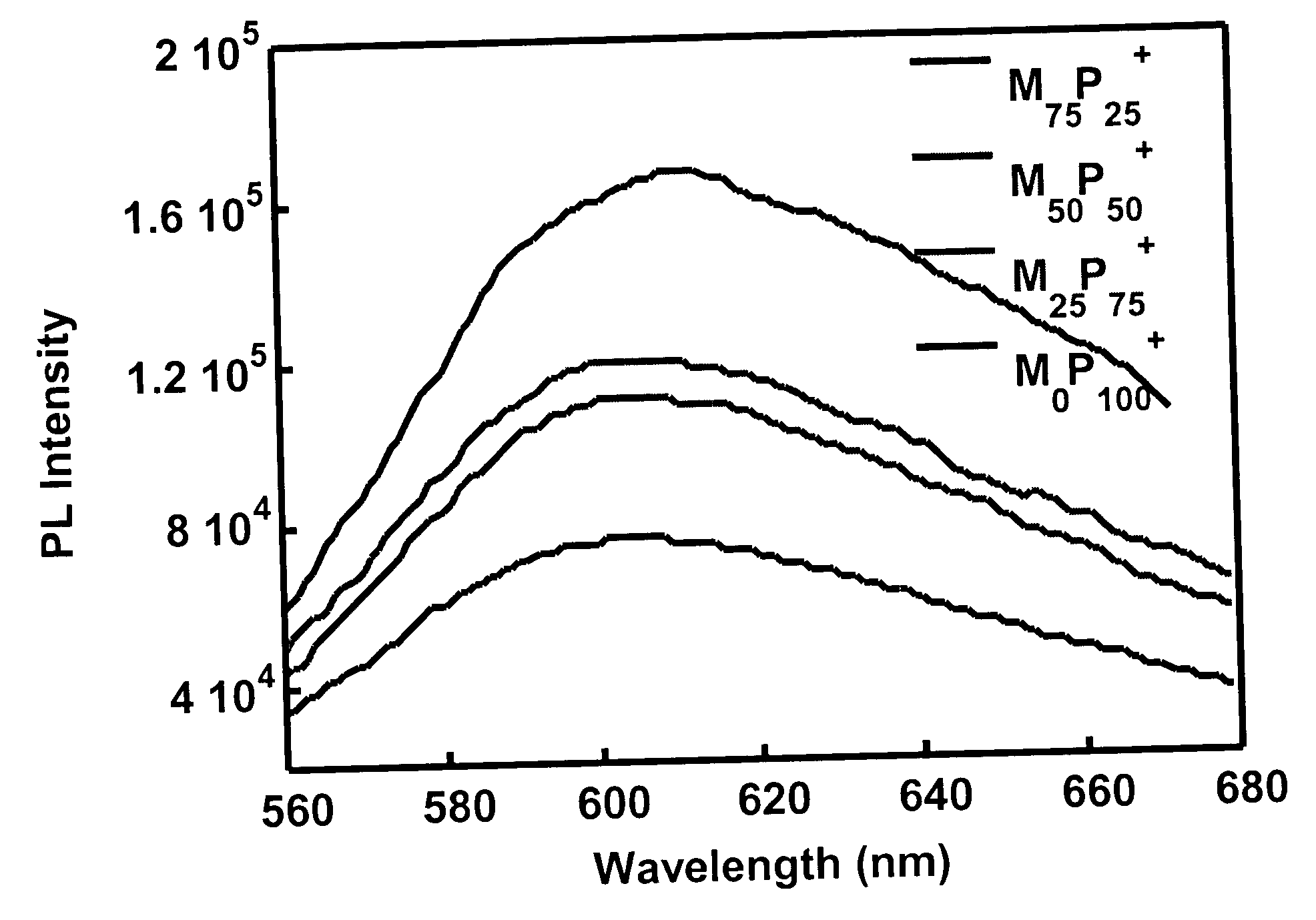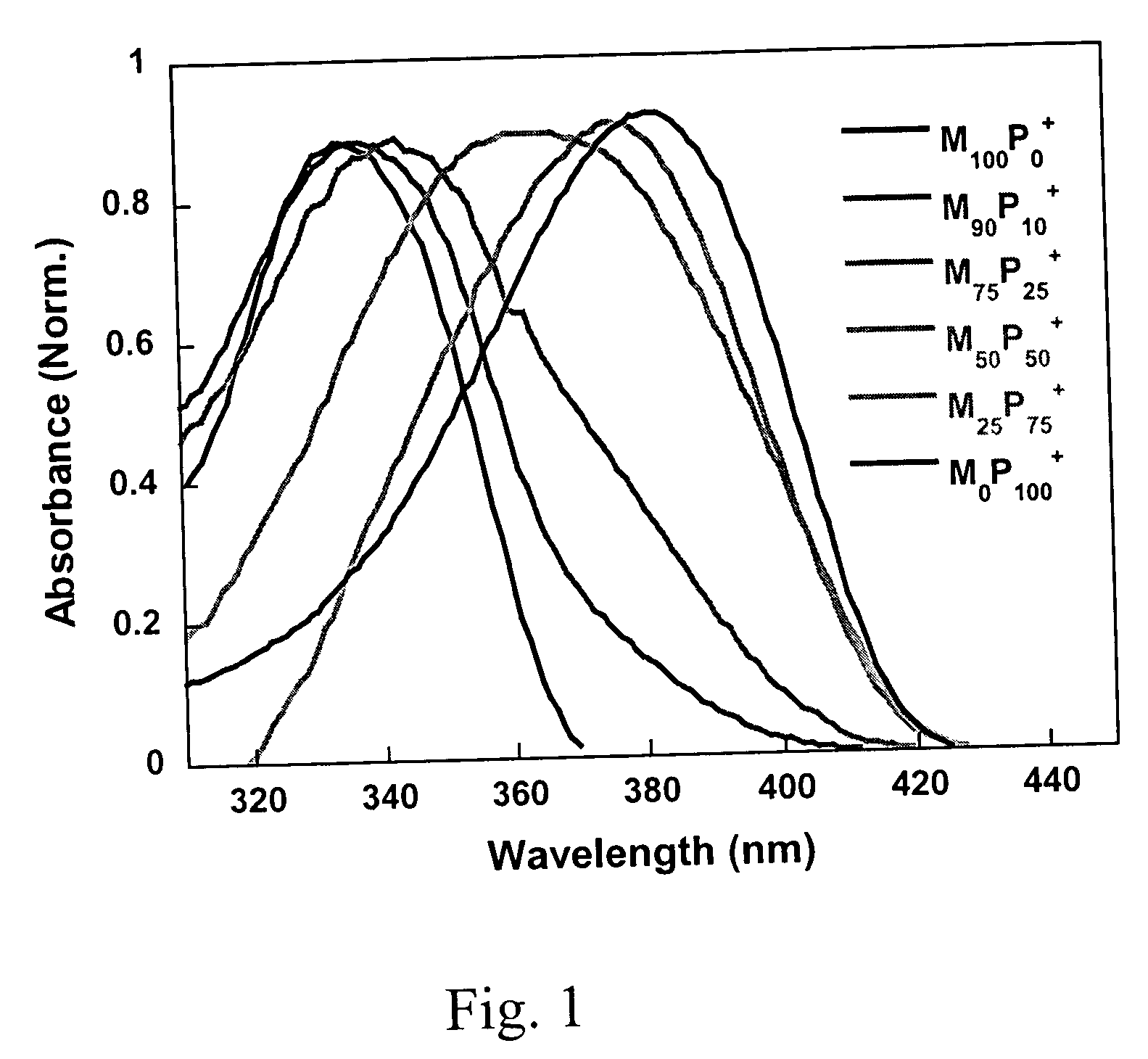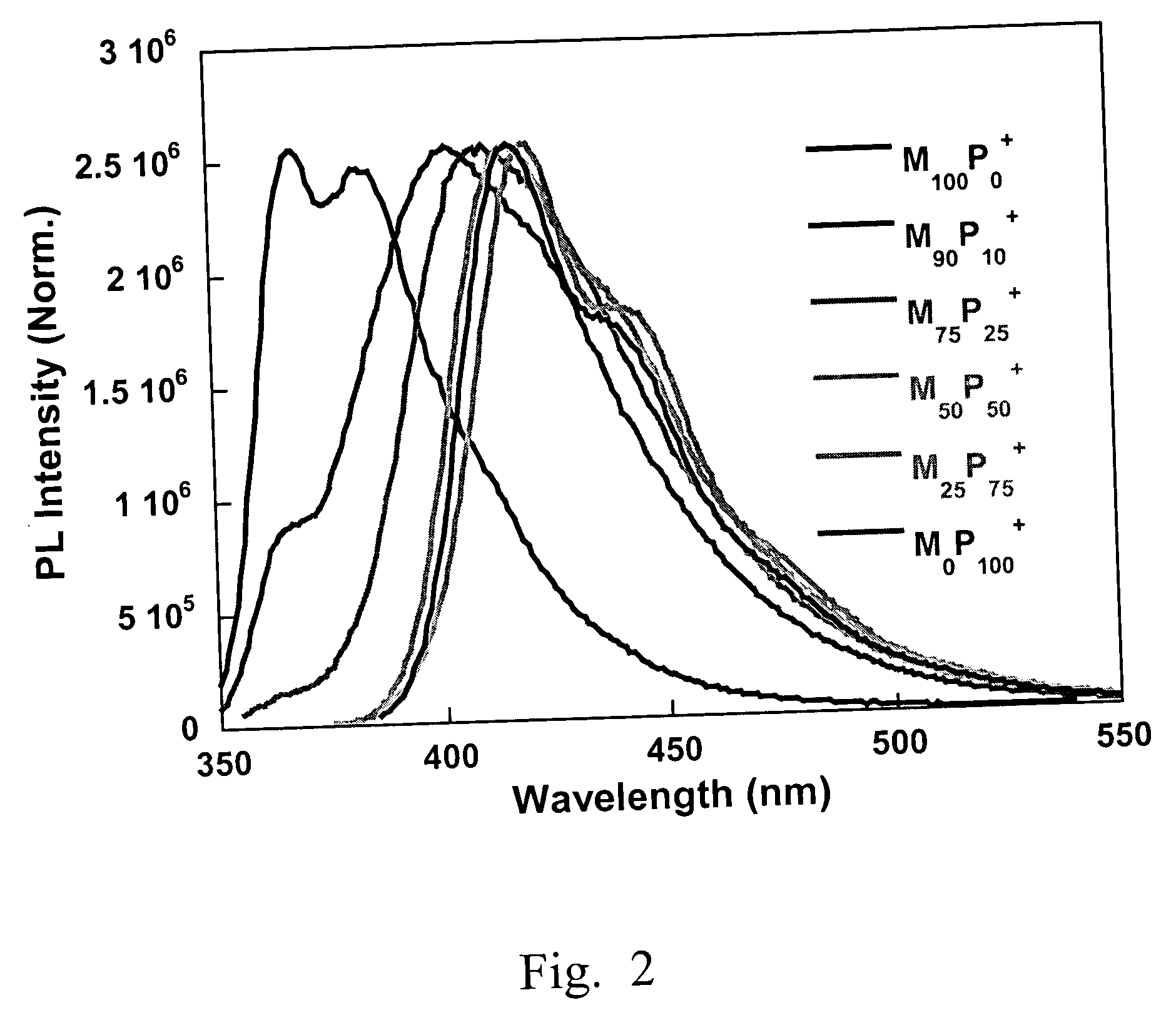Conformationally flexible cationic conjugated polymers
a conjugated polymer, flexible technology, applied in the direction of conductive materials, film/foil adhesives, medical preparations, etc., can solve the problems of limiting the conformation and adaptability of polymers, deleterious fluorescence self-quenching, and rigid rod structure of polymers, so as to reduce the self-quenching in solution, reduce the chain packing, and control the emission properties
- Summary
- Abstract
- Description
- Claims
- Application Information
AI Technical Summary
Benefits of technology
Problems solved by technology
Method used
Image
Examples
example 1
1,3-Bis(4,4,5,5,-tetramethyl-1,3,2-dioxaborolan)phenylene (1).
A flask charged with 1,3-diiodobenzene (1.0 g, 3 mmol), bis(pinacolato)diborane (2.3 g, 9 mmol), potassium acetate (2.1 g, 21 mmol), PdCl2(dppf) (150 mg, 0.18 mmol), and 15 mL of anhydrous DMSO was degassed for 15 minutes. The mixture was stirred at 80° C. for 12 h, cooled to room temperature and then poured into 100 mL of ice water. The mixture was extracted with CHCl3, and the combined organic layers were dried over anhydrous MgSO4. After the solvent was evaporated, the residue was purified by chromatography using silica gel (Hexane:CHCl3=1:1) and then recrystallized from ethanol to afford 1 (460 mg, 46%) as a white solid. 1H NMR (200 MHz, CDCl3): δ 8.28 (s, 1H), 7.91-7.89 (d, 2H), 7.38 (t, 1H), 1.35 (s, 24H). 13C NMR (50 MHz, CDCl3): δ 141.4, 137.8, 127.3, 83.9, 25.1.
example 2
2,7-Dibromo-9,9-bis(6′-bromohexyl)fluorene (2).
To a mixture of tetrabutylammonium bromide (300 mg, 9.3 mmol), aqueous potassium hydroxide (100 mL, 50%) and 1,6-dibromohexane (22.6 g, 92.6 mmol) was added 2,7-dibromofluorene at 75° C. After 15 minutes, the mixture was cooled down to room temperature, and extracted with CH2Cl2. The organic layer was washed with water, aqueous HCl, water and brine, dried over MgSO4, and then concentrated. Unreacted 1,6-dibromohexane was distilled off. The residue was purified by silica gel column chromatography (Hexane:CHCl3=9:1) and recrystallized from ethanol to give 2 (4.8 g, 80%) as a white solid. 1H NMR (200 MHz, CDCl3): δ 7.2-7.4 (m, 6H), 3.12 (t, 4H), 1.75 (t, 4H), 1.5 (m, 4H), 1.0 (m, 8H), 0.4 (m, 4H). 13C NMR (50 MHz, CDCl3): δ 152.3, 139.2, 130.5, 126.2, 121.7, 121.4, 55.7, 40.2, 34.1, 32.8, 29.1, 27.9, 23.6.
example 3
Poly(9,9-bis(6′-bromohexyl)fluorene-co-alt-1,3-phenylene) (M100P0).
2,7-Dibromo-9,9-bis(6′-bromohexyl)fluorene (325 mg, 0.5 mmol), 1,3-bis(4,4,5,5-tetramethyl-1,3,2-dioxaborolan)phenylene (166 mg, 0.5 mmol), Pd(PPh3)4 (8 mg) and potassium carbonate (830 mg, 6 mmol) were placed in a 25 mL round bottle flask. A mixture of water (3 mL) and toluene (5 mL) was added to the flask. After degassing, the mixture was refluxed at 85° C. for 20 h, and then precipitated into methanol. The polymer was filtered and washed with methanol and acetone, and then dried in vacuum for 24 h to afford M100P0 (251 mg, 88%) as a light yellow solid. 1H NMR (200 MHz, CDCl3): δ 7.9-7.6 (m, 10H), 3.3-3.2 (t, 4H), 2.1 (m, 4H), 1.7-1.6 (m, 4H), 1.3-1.2 (m, 8H), 0.8 (m, 4H). 13C NMR (50 MHz, CDCl3):δ 152.1, 142.9, 140.9, 130.1, 129.5, 128.0, 126.8, 122.5, 120.9, 55.9, 40.9, 34.5, 33.3, 29.7, 28.5, 24.3. GPC (THF, polystyrene standard), Mw: 40,250 g / mol; Mn: 14,980 g / mol; PDI: 2.8. UV-vis (CHCl3): αmax=337 nm; PL (...
PUM
| Property | Measurement | Unit |
|---|---|---|
| angle | aaaaa | aaaaa |
| angle | aaaaa | aaaaa |
| angle | aaaaa | aaaaa |
Abstract
Description
Claims
Application Information
 Login to View More
Login to View More - R&D
- Intellectual Property
- Life Sciences
- Materials
- Tech Scout
- Unparalleled Data Quality
- Higher Quality Content
- 60% Fewer Hallucinations
Browse by: Latest US Patents, China's latest patents, Technical Efficacy Thesaurus, Application Domain, Technology Topic, Popular Technical Reports.
© 2025 PatSnap. All rights reserved.Legal|Privacy policy|Modern Slavery Act Transparency Statement|Sitemap|About US| Contact US: help@patsnap.com



